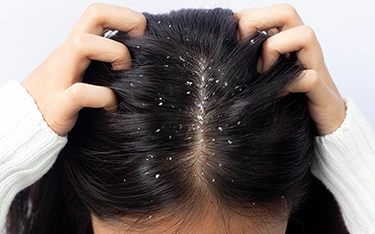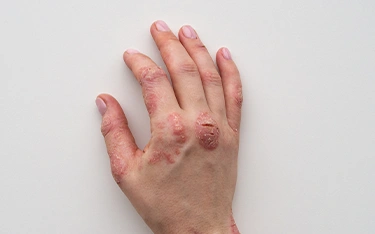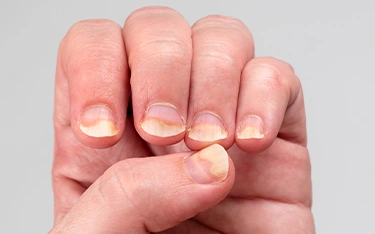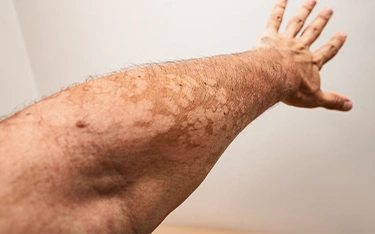Malassezia is a genus of lipophilic (oil-loving) yeast that’s part of your skin’s normal microbiome. It thrives in oily areas like the scalp, face, upper chest, and back.
Most of the time, it’s harmless. But when things go sideways - like excess oil, humidity, stress, or a weakened skin barrier - it can multiply fast and cause problems.
Each species of Malassezia behaves differently and is linked to specific skin concerns depending on where it thrives on the body. Here's an overview of the most common types found on human (and in rare cases, animal) skin:
| Species |
Primary Habitat |
Associated Conditions |
Key Characteristics |
| M. globosa |
Scalp, upper trunk |
Dandruff, seborrheic dermatitis |
Breaks down skin oils (sebum) and releases irritants |
| M. furfur |
Face, chest |
Tinea versicolor, folliculitis |
Produces pigments, can cause skin discolouration |
| Produces pigments, can cause skin discolouration |
Scalp |
Dandruff, seborrheic dermatitis |
Thrives in oily and acidic environments |
| M. sympodialis |
Trunk, arms |
Atopic dermatitis |
Mildly inflammatory, less aggressive |
| M. pachydermatis |
Pets (rare in humans) |
Pets (rare in humans) |
Mostly found in animals, occasionally transmitted to humans |
While part of the skin’s natural ecosystem, an overgrowth of Malassezia can interfere with normal skin functions, leading to inflammation, persistent itching, flaking, acne-like eruptions, and other visible discomforts.
Also Read: Homeopathic Treatment for Acne
Understanding the behaviour and habitat of each species is crucial for effective diagnosis and treatment.
Also Read: Causes & Treatments for Oily Dandruff
Malassezia on the Scalp
Dandruff and Seborrheic Dermatitis
Dandruff caused by Malassezia is one of the most common scalp conditions worldwide. The yeast feeds on natural oils and breaks them down into fatty acids that can irritate the scalp. This triggers flaking, redness, and itching.
In more severe cases, dandruff progresses to seborrheic dermatitis, where greasy, inflamed patches appear around the scalp, eyebrows, and behind the ears.
Related Reading:
Scalp Folliculitis and Sensitivity
Overgrowth of Malassezia may also lead to scalp folliculitis - tiny, itchy pustules that resemble acne. Inflammation may contribute to scalp sensitivity or even temporary hair shedding in severe cases.
Signs You May Have a Malassezia-Related Scalp Issue:
- Persistent flaking despite regular shampoo use
- Greasy, red, or irritated patches around the hairline and ears
- Itchy scalp that worsens with humidity
- Small pustules or bumps along the scalp
- Family history of dandruff or seborrheic dermatitis
Related Reading:
Malassezia and Facial Skin
Malassezia can also affect facial skin, particularly in oil-prone areas. Conditions may include:
- Pityrosporum folliculitis – Itchy, acne-like bumps on the face, chest, or back
- Facial seborrheic dermatitis – Red, flaky patches around the nose, eyebrows, or ears
- Tinea versicolor – Discoloured patches (light or dark) on the upper body
Symptoms to Watch For:
- Persistent redness or scaling in the T-zone (forehead, nose, chin)
- Uniform bumps that resemble acne but do not respond to typical acne treatments
- Itchiness that worsens with sweat or oil
- Flare-ups during hot and humid weather
What Triggers Malassezia Overgrowth?
Although Malassezia is a normal resident of healthy skin, certain conditions can tip the balance, leading to its rapid multiplication and the onset of skin or scalp problems. Understanding these triggers is key to both prevention and treatment.
| Root Cause |
Why It Matters |
| Excess Sebum Production |
Provides an abundant food source for Malassezia, encouraging rapid overgrowth. |
| Warm, Humid Environments |
Creates the perfect climate for yeast to thrive, especially in oil-prone areas. |
| Altered Skin pH |
Disrupts the skin’s natural microbial balance, allowing Malassezia to dominate. |
| Weakened Skin Barrier |
Makes the skin more vulnerable to irritation, infection, and inflammation. |
| Hormonal Imbalances & Stress |
Makes the skin more vulnerable to irritation, infection, and inflammation. |
By identifying and managing these triggers, individuals can significantly reduce the chances of recurring Malassezia-related concerns. At Dr Batra’s®, our experts assess these underlying causes to create a targeted, long-term solution tailored to each patient’s unique skin profile.





